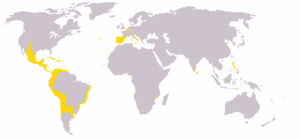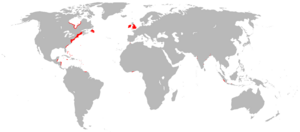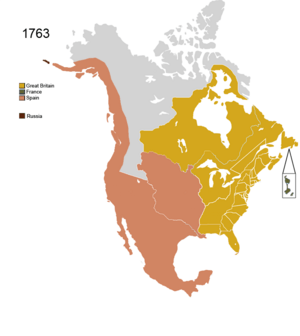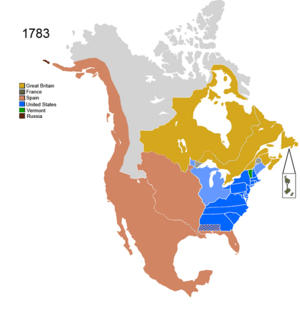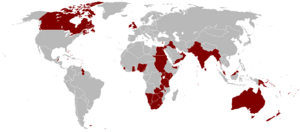British colonization of the Americas facts for kids
The British colonization of the Americas was when England, Scotland, and later Great Britain, started to control, settle, and build colonies across the Americas. This effort began in the 1600s. The first lasting English colony was set up in Jamestown, Virginia in 1607. About 30,000 Algonquian people lived there at that time.
Over the next few centuries, more British colonies were created in North America, Central America, South America, and the Caribbean. Most of these colonies eventually became independent countries. However, some chose to stay connected to Britain and are now called British Overseas Territories.
The first Europeans known to settle in the Americas were the Norse people, led by Leif Erikson, around 1000 AD. They settled in what is now Newfoundland, calling it Vinland. Later, European exploration restarted with Christopher Columbus's journey in 1492, sponsored by Spain. English exploration began almost a century later. Sir Walter Raleigh tried to start the Roanoke Colony in 1585, but it didn't last.
The Jamestown colony in 1607 grew into the Colony of Virginia. Another settlement, Virgineola (now Bermuda), was accidentally settled in 1609 after a shipwreck. In 1620, a group of Puritans called the Pilgrims started a second permanent colony in Massachusetts. Many other English colonies were set up in North America during the 1600s and 1700s. The Hudson's Bay Company also gained control of a large area called Rupert's Land for fur trading. The English also took over or started several colonies in the Caribbean, like Barbados and Jamaica.
In the mid-1600s, England captured the Dutch colony of New Netherland. This left North America mostly divided between the English, Spanish, and French. After many wars with France, Britain took control of the French colony of Canada and some Caribbean lands in 1763. Many North American colonies became independent from Britain after winning the American Revolutionary War, which ended in 1783.
Historians call the British Empire after 1783 the "Second British Empire." During this time, Britain focused more on Asia and Africa, and on expanding trade rather than just gaining land. Still, Britain continued to colonize parts of the Americas in the 1800s. They took control of British Columbia and established the Falkland Islands and British Honduras. Britain also gained colonies like Trinidad and British Guiana after defeating France in the Napoleonic Wars in 1815.
In the mid-1800s, Britain began to let its remaining North American colonies govern themselves. Most of these colonies joined to form Canada in the 1860s or 1870s, though Newfoundland joined later in 1949. Canada became fully independent in 1931, but still recognizes the British monarch as its head of state. After the Cold War began, most of the remaining British colonies in the Americas became independent between 1962 and 1983. Many former British colonies are now part of the Commonwealth of Nations, a group of mostly former British Empire countries.
Contents
Early European Exploration and Settlement
After Christopher Columbus's first trip in 1492, Spain and Portugal started colonies in the New World. Soon after, France and England, other big European powers, sent their own explorers. In 1497, King Henry VII of England sent John Cabot to explore North America. But because they didn't find gold or other riches, neither the Spanish nor the English settled there permanently right away.
Later explorers like Martin Frobisher and Henry Hudson searched for a Northwest Passage (a sea route) between the Atlantic Ocean and Asia. They didn't find one. Europeans did set up fishing spots in the Grand Banks of Newfoundland. They traded metal, glass, and cloth for food and fur with Native Americans, starting the North American fur trade. In 1585, an English expedition led by Bernard Drake weakened the Spanish and Portuguese fishing fleets, which helped England's future colonial plans.
In the Caribbean Sea, English sailors often ignored Spanish trade rules and attacked Spanish treasure ships. England's colonization in America was partly based on how they had colonized Ireland, especially the Munster Plantation. Many early North American colonists had first gained experience in Ireland. For example, when Sir Walter Raleigh landed in Virginia, he compared the Native Americans to the "wild Irish." Both the Roanoke and Jamestown colonies were planned using the Irish plantation model.
In the late 1500s, Protestant England was at war with Catholic Spain. English privateers like Francis Drake and Humphrey Gilbert attacked Spanish ships to weaken Spain. Gilbert suggested colonizing North America like Spain had, to create a rich English empire and a base for privateers. After Gilbert died, Walter Raleigh continued the idea, sending 500 men to Roanoke Island. In 1584, they started the first English colony in North America, but the colonists were not ready for life there. By 1590, they had disappeared.
There are many ideas about what happened to the Roanoke colonists. A popular theory is that they moved to a new area and some joined local Native American tribes. Another attempt to colonize Newfoundland also failed. Despite these early failures, England stayed interested in North America for economic and military reasons.
First Colonies, 1607–1630
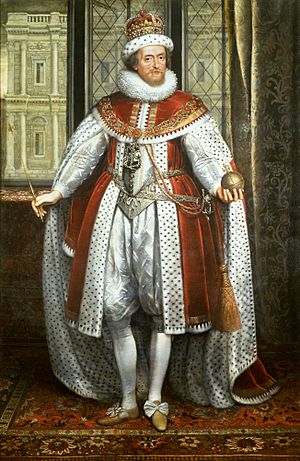
In 1606, King James I of England gave permission to two companies, the Plymouth Company and the London Company, to set up permanent settlements in North America. In 1607, the London Company started a colony at Jamestown in the Chesapeake Bay. The Plymouth Company's Popham Colony didn't last long. About 30,000 Algonquian people lived in the Jamestown area at the time.
The Jamestown colonists faced huge challenges. By 1617, only 351 out of 1700 colonists had survived. But after they found out how profitable tobacco was, the colony grew quickly. The London Company went bankrupt partly because of frequent wars with local Native Americans. This led the English king to take direct control of the Colony of Virginia, which included Jamestown.
In 1609, the Sea Venture, a ship carrying leaders for Jamestown, was deliberately steered onto a reef off Bermuda during a hurricane. The 150 passengers and crew built two new ships and mostly left for Jamestown in 1610. A few people stayed behind, ensuring Bermuda remained an English possession. Bermuda was officially named Virgineola, then The Somers Isles, but the older Spanish name of Bermuda stuck.
Bermuda soon became more populated and successful than Jamestown. A new company, the Somers Isles Company, was created for Bermuda in 1615. Bermuda also grew tobacco, but Virginia's tobacco farms soon produced more. As tobacco prices fell, Bermudians started building their own ships, like the fast Bermuda sloop, to trade food with other Caribbean colonies.
Between the late 1610s and the American Revolution, Britain sent an estimated 50,000 to 120,000 convicts to its American colonies.
Meanwhile, the Council for New England supported other colonization projects. One was a colony started by English Puritans, known as the Pilgrims. These Puritans wanted to be independent from the Church of England. In 1620, the Mayflower brought the Pilgrims to Cape Cod, where they established Plymouth Colony. They had a very difficult first winter, with about half of the hundred colonists dying. In 1621, Plymouth Colony made an alliance with the Wampanoag tribe, which helped them learn farming and trade furs. Further north, the English also established Newfoundland Colony in 1610, focusing mainly on cod fishing.
The Caribbean would become home to some of England's most important and profitable colonies, but not without early failures. An attempt to colonize Guiana in 1604 lasted only two years and failed to find gold. Colonies in St Lucia (1605) and Grenada (1609) also quickly failed. Encouraged by Virginia's success, King Charles I allowed the Barbados Company to settle the uninhabited Caribbean island of Barbados in 1627. Early settlers failed with tobacco but found great success growing sugar.
Growth of Colonies, 1630–1689
Caribbean Colonies
The success in Barbados led to more Caribbean colonies. By 1660, England had sugar colonies in St. Kitts, Antigua, Nevis, and Montserrat. English colonization of the Bahamas began in 1648. England took another sugar colony in 1655 after successfully invading Jamaica during a war with Spain. Spain officially recognized English control of Jamaica and the Caiman Islands in 1670. England also captured Tortola from the Dutch in 1670, and later took Anegada and Virgin Gorda, which together formed the British Virgin Islands.
During the 1600s, these sugar colonies adopted the plantation system used by the Portuguese in Brazil, which relied on slave labour. The English government saw these islands as more economically important than New England. Until Britain stopped its slave trade in 1807, it transported 3.5 million African slaves to the Americas, a third of all slaves moved across the Atlantic. Many slaves were captured by the Royal African Company in West Africa. These slaves soon became the majority of the population in Caribbean colonies like Barbados and Jamaica, where strict slave codes were put in place to prevent slave rebellions.
The Thirteen Colonies
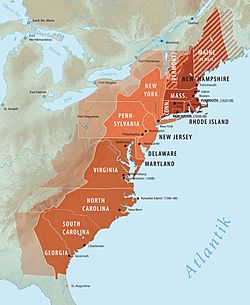
Dark Red = New England colonies.
Bright Red = Middle Atlantic colonies.
Red-brown = Southern colonies.
New England Colonies
After Jamestown and Plymouth succeeded, more English groups started colonies in what became New England. In 1629, another group of Puritans led by John Winthrop founded the Massachusetts Bay Colony. By 1635, about ten thousand English settlers lived between the Connecticut River and the Kennebec River. After defeating the Pequot in the Pequot War, Puritan settlers created the Connecticut Colony in the land the Pequots once controlled. The Colony of Rhode Island and Providence Plantations was founded by Roger Williams, a Puritan leader who was kicked out of Massachusetts Bay Colony for wanting a clear separation from the Church of England. Because New England was cold and had less fertile land, the New England Colonies relied on fishing and long-distance trade.
Southern Colonies
In 1632, Cecil Calvert, 2nd Baron Baltimore founded the Province of Maryland north of Virginia. Maryland and Virginia became known as the Chesapeake Colonies and had similar immigration and economic activities. Baltimore wanted Maryland to be a safe place for Catholics, but most immigrants were Protestants. In the mid-1600s, the Chesapeake Colonies, seeing the success of slavery in Barbados, began to bring in large numbers of African slaves. While some early slaves eventually became free, after 1662 Virginia passed laws that made enslaved status pass from mother to child and gave slave owners almost complete control over their slaves.
Bermuda, another former Virginia Company settlement, was still run by the Somers Isles Company. The company and its shareholders in England only made money from tobacco exports. This caused problems with Bermudians, who found tobacco farming unprofitable. Bermuda sided with the King during the English Civil War. After the war, Bermudians complained to the King about the Somers Isles Company. In 1684, the King took direct control of Bermuda. From then on, Bermudians stopped farming much and focused on shipping and trade between North America and the West Indies. Bermudians also settled in other colonies, especially the southern ones like Carolina, which was settled from Bermuda in 1670.
Encouraged by Spain's weakness in Spanish Florida, Barbadian planter John Colleton and others started the Province of Carolina in 1663. Settlers in Carolina created two main population centers: Virginians settled in the north, and English Barbadians settled in the southern port city of Charles Town. In 1729, after the Yamasee War, Carolina was split into North Carolina and South Carolina. Maryland, Virginia, North Carolina, and South Carolina (along with the Province of Georgia, founded in 1732) became known as the Southern Colonies.
Middle Colonies

Starting in 1609, Dutch traders set up fur trading posts on the Hudson River, Delaware River, and Connecticut River, forming the Dutch colony of New Netherland, with its capital at New Amsterdam. In 1657, New Netherland grew by conquering New Sweden, a Swedish colony. Despite its business success, New Netherland didn't attract as many settlers as the English colonies. In 1664, during a series of wars between England and the Dutch, English soldier Richard Nicolls captured New Netherland. The Dutch briefly got parts of it back but gave up their claim in 1674, ending their colonial presence in North America.
In 1664, the Duke of York, who later became James II of England, was given control of the English colonies north of the Delaware River. He created the Province of New York from the former Dutch land and renamed New Amsterdam to New York City. He also created West Jersey and East Jersey from former Dutch land west of New York City. These two Jerseys later became the Province of New Jersey in 1702.
King Charles II gave William Penn, the son of a famous admiral, the land between Maryland and the Jerseys. Penn named this land the Province of Pennsylvania. He also leased the Delaware Colony, which got its own legislature in 1701. Penn, a devout Quaker, wanted to create a place of religious toleration in the New World. Pennsylvania attracted Quakers and other settlers from across Europe, and Philadelphia quickly became a busy port city. With its fertile and cheap land, Pennsylvania became a very popular place for immigrants in the late 1600s. New York, Pennsylvania, New Jersey, and Delaware became known as the Middle Colonies.
Hudson's Bay Company
In 1670, King Charles II gave a special permission, called a royal charter, to the Hudson's Bay Company (HBC). This gave the company a monopoly (sole right) to the fur trade in an area called Rupert's Land. French forces often attacked the forts and trading posts built by the HBC.
Darien Scheme
In 1695, the Parliament of Scotland gave a charter to the Company of Scotland. This company tried to set up a settlement in 1698 on the Isthmus of Panama. However, Spanish colonists from nearby New Granada attacked them, and many colonists got malaria. The colony was abandoned two years later. The Darien scheme was a huge financial disaster for Scotland, losing a quarter of all Scottish money invested. This ended Scotland's hopes of having its own overseas empire. This event also had big political effects, convincing both England and Scotland that they should unite as countries, not just have the same king. This happened in 1707 with the Treaty of Union, creating the Kingdom of Great Britain.
Expansion and Conflicts, 1689–1763
Settlement and Growth in North America
After King James II was replaced by William and Mary in the Glorious Revolution of 1688, many of James's colonial policies were continued. These included the mercantilist Navigation Acts, which controlled colonial trade, and the Board of Trade. The Massachusetts Bay Colony, Plymouth Colony, and the Province of Maine were combined into the Province of Massachusetts Bay. New York and Massachusetts Bay Colony became royal colonies, meaning the king appointed their governors. Maryland also became a royal colony after a local uprising. Even colonies that kept their original permissions had to accept much more control from the king than before the 1690s.
Between immigration, the arrival of slaves, and natural population growth, the number of people in British North America grew hugely in the 1700s. By 1750, the Thirteen Colonies (which would later form the United States) had 1.5 million people. More than 90% of colonists were farmers, but cities like Philadelphia, New York, and Boston also grew. After the Dutch were defeated and the Navigation Acts were enforced, British colonies in North America became part of Britain's worldwide trading network. Colonists traded food, wood, tobacco, and other goods for Asian tea, West Indian coffee, and sugar. Native Americans living further inland traded beaver fur and deerskins. By 1770, the Thirteen Colonies' economy made up 40% of the entire British Empire's economic output.
Before 1660, almost all immigrants to English North America came freely, though many paid for their trip by becoming indentured servants (working for a set time to pay off their debt). Better economic conditions in Europe made it harder to find free workers for the colonies in the 1600s and 1700s. Because of this labor shortage, the number of slaves in British North America grew a lot between 1680 and 1750. This growth was due to both forced immigration and slaves having children. In the Southern Colonies, where slave labor was most used, slaves supported huge plantations run by rich landowners. By 1775, slaves made up one-fifth of the population in the Thirteen Colonies. While fewer English people moved to British North America after 1700, the colonies attracted new immigrants from other European countries, including Irish Catholics and German Protestants. As the 1700s continued, colonists began to settle further from the Atlantic coast, moving west into the Ohio River valley.
After the Somers Isles Company's royal charter was taken away in 1684, Bermudian sailors created a trade network between colonies. Charleston, South Carolina became a major hub for their trade. The widespread activities of Bermudians led to many places in North America being named after Bermuda.
Wars with France and Spain
The Glorious Revolution and the new king, William III, meant that England and its colonies would fight with the French empire after 1689. Under Samuel de Champlain, the French had founded Quebec City in 1608, which became the center of the French colony of Canada. France and England fought proxy wars (wars using others as fighters) through Native American allies during and after the Nine Years' War. The powerful Iroquois tribe remained neutral. War between France and England continued in Queen Anne's War. In the 1713 Treaty of Utrecht, which ended the war, Britain gained the French territories of Newfoundland and Acadia, which was renamed Nova Scotia. In the 1730s, James Oglethorpe suggested colonizing the area south of the Carolinas to create a buffer against Spanish Florida. This area became the Province of Georgia. Oglethorpe hoped to create a colony without slavery, but by 1750, it was still sparsely populated and became a royal colony in 1752.
In 1754, the Ohio Company began building a fort where the Allegheny River and the Monongahela River meet. A larger French force initially drove the Virginians away, but then had to retreat after the Battle of Jumonville Glen. When news of this battle reached France and Britain, the Seven Years' War broke out in 1756. In North America, this war is known as the French and Indian War. After 1758, the British won many victories, conquering much of New France by the end of 1760. Spain joined the war on France's side in 1762 and quickly lost several American territories to Britain. The 1763 Treaty of Paris ended the war. France gave almost all of its land east of the Mississippi River to the British. France also gave its lands west of the Mississippi River to Spain, and Spain gave Florida to Britain. With these new lands, the British created the provinces of East Florida, West Florida, and Quebec. In the Caribbean, Britain kept Grenada, St. Vincent, Dominica, and Tobago, but returned control of Martinique, Havana, and other colonies to France or Spain.
The Americans Break Away, 1763–1783
British people in North America believed the unwritten British constitution protected their rights. They thought the government, with the House of Commons, the House of Lords, and the monarch, had a good balance of power. However, Britain had huge debts after the French and Indian War. Since much of this debt came from defending the colonies, British leaders felt the colonies should pay more. They started imposing taxes, like the Sugar Act of 1764.
Increased British control upset the colonists and challenged their idea that they were equal partners in the British Empire. To avoid another expensive war with Native Americans, Britain issued the Royal Proclamation of 1763, which limited settlement west of the Appalachian Mountains. This was later replaced by the Treaty of Fort Stanwix five years later. The Thirteen Colonies became divided between Patriots, who opposed taxes without representation, and Loyalists, who supported the king. In other British colonies near the Thirteen Colonies, protests were quieter because most colonists accepted the new taxes. These provinces had smaller populations, relied on the British military, and had less experience with self-rule.
At the Battles of Lexington and Concord in April 1775, the Patriots fought off a British force. The Second Continental Congress met in May 1775 to organize armed resistance. They set up a temporary government, recruited soldiers, and printed their own money. On July 4, 1776, they declared a permanent break with Britain, adopting the Declaration of Independence for the United States of America. France formed a military alliance with the United States in 1778 after the British defeat at the Battle of Saratoga. Spain joined France to try and get Gibraltar back from Britain. A combined French and American force trapped a British army at Yorktown, Virginia, forcing them to surrender in October 1781. This surrender shocked Britain. The king wanted to keep fighting, but he lost control of Parliament, and peace talks began. In the 1783 Treaty of Paris, Britain gave up all its North American territory south of the Great Lakes, except for the two Florida colonies, which went to Spain.
Bermudians had close ties with the continental colonies, especially Virginia and South Carolina. They leaned towards the rebels during the American War of Independence, supplying them with ships and gunpowder. However, the strong presence of the Royal Navy meant they couldn't join the rebellion. Bermuda then used privateering against their former allies. Bermuda is closer to Canada than to the West Indies, and its nearest land is North Carolina. After the United States became independent, Bermuda became very important for Britain's control of the region and its ability to protect shipping and project power against the United States, as seen in the American War of 1812.
After defeating a combined French and Spanish naval force in the 1782 Battle of the Saintes, Britain kept control of Gibraltar and all its Caribbean possessions from before the war, except for Tobago. Economically, the new United States became a major trading partner for Britain.
Second British Empire, 1783–1945
Losing a large part of British America marked a shift for the British Empire. Britain began to focus more on Asia, the Pacific, and later Africa. Influenced by Adam Smith's ideas, Britain also moved away from strict trade controls and focused more on expanding trade rather than just gaining land. In the 1800s, some people described Britain as having an "unofficial" empire based on exporting goods and investing money around the world, including in the newly independent countries of Latin America. While this unofficial empire didn't require direct British political control, it often involved using military force to protect British investments and ensure free trade.
From 1793 to 1815, Britain was almost constantly at war, first in the French Revolutionary Wars and then in the Napoleonic Wars. During these wars, Britain took control of many French, Spanish, and Dutch Caribbean colonies. Tensions between Britain and the United States grew during the Napoleonic Wars. The United States tried to take advantage of its neutrality to trade with French-controlled ports, while Britain tried to stop this trade. The Royal Navy needed many sailors and often lost them to American merchant ships. So, they would stop American ships to search for deserters, sometimes forcing American sailors into the Royal Navy. The United States also wanted to take over Canada, which Britain needed for timber for its ships. Taking advantage of Britain's war with France, the United States started the American War of 1812 by invading Canada. However, the British Army, with help from local militias and Native American allies, successfully defended Canada. The Royal Navy also blockaded the U.S. Atlantic coast from Bermuda, stopping its trade, and carried out raids like the Chesapeake Campaign, which included the Burning of Washington. Since the U.S. didn't gain any land before Britain defeated France in 1814, the war ended with the same borders as before, ensuring Canada's future was separate from the United States.
After French Emperor Napoleon was finally defeated in 1815, Britain gained ownership of Trinidad, Tobago, British Guiana, and Saint Lucia, as well as other territories outside the Americas. The Treaty of 1818 with the United States set a large part of the Canada–United States border at the 49th parallel. It also established joint U.S.-British control over Oregon Country. In the 1846 Oregon Treaty, the U.S. and Britain agreed to split Oregon Country along the 49th parallel, except for Vancouver Island, which went entirely to Britain.
After fighting throughout the 1700s and 1800s, Britain and France made lasting peace after 1815. Britain fought only one war against a European power for the rest of the 1800s (the Crimean War), and it didn't change territories in the Americas. However, the British Empire continued to fight wars like the First Opium War against China. It also put down rebellions like the Indian Rebellion of 1857, the Canadian Rebellions of 1837–1838, and the Jamaican Morant Bay rebellion of 1865. A strong movement to end slavery grew in the United Kingdom in the late 1700s, and Britain abolished the slave trade in 1807. In the mid-1800s, the economies of British Caribbean colonies suffered because of the Slavery Abolition Act 1833, which ended slavery throughout the British Empire, and the 1846 Sugar Duties Act, which removed special tariffs for sugar from the Caribbean. To replace the labor of former slaves, British plantations in Trinidad and other parts of the Caribbean began to hire indentured servants from India and China.
Creating the Dominion of Canada
Despite losing the American Revolutionary War and shifting its imperial focus, the British Empire kept many colonies in the Americas after 1783. During and after the American Revolutionary War, between 40,000 and 100,000 defeated Loyalists moved from the United States to Canada. The 14,000 Loyalists who went to the Saint John and Saint Croix river valleys, then part of Nova Scotia, felt too far from the government in Halifax. So, London made New Brunswick a separate colony in 1784. The Constitutional Act of 1791 created the provinces of Upper Canada (mostly English-speaking) and Lower Canada (mostly French-speaking) to ease tensions between the French and British communities. It also set up governments similar to Britain's, aiming to keep imperial control and prevent the kind of popular government that led to the American Revolution.
The British also expanded their trade interests in the North Pacific. Spain and Britain became rivals there, leading to the Nootka Crisis in 1789. Both sides prepared for war, but Spain backed down when France refused to support it. This was a humiliation for Spain and a victory for Britain, as Spain gave up almost all its claims on the North Pacific coast. This opened the way for British expansion. Several expeditions took place, including a naval expedition led by George Vancouver that explored the inlets around the Pacific NorthWest, especially Vancouver Island. On land, expeditions searched for a river route to the Pacific for the North American fur trade. Sir Alexander Mackenzie led the first in 1792. A year later, he became the first European to reach the Pacific overland north of the Rio Grande, near present-day Bella Coola. This happened twelve years before the Lewis and Clark Expedition. Shortly after, Mackenzie's companion, John Finlay, founded the first permanent European settlement in British Columbia, Fort St. John. The North West Company continued explorations, pushing into the Rocky Mountains and all the way to the Strait of Georgia on the Pacific Coast, expanding British North America westward.
In 1815, Lieutenant-General Sir George Prevost was the top military and civil leader for all of British North America, including Canada, Nova Scotia, New Brunswick, Newfoundland, Prince Edward Island, Cape Breton, and Bermuda.
In response to the Rebellions of 1837–1838, Britain passed the Act of Union in 1840, which combined Upper Canada and Lower Canada into the Province of Canada. Responsible government (where the government is accountable to the elected representatives) was first granted to Nova Scotia in 1848 and soon extended to other British North American colonies. With the passage of the British North America Act, 1867 by the British Parliament, Upper and Lower Canada, New Brunswick, and Nova Scotia formed the confederation of Canada. Rupert's Land, British Columbia, and Prince Edward Island joined Canada by the end of 1873, but Newfoundland didn't join until 1949. Like other British dominions such as Australia, New Zealand, and South Africa, Canada had control over its own affairs but recognized the British monarch as its head of state and worked closely with Britain on defense. After the 1931 Statute of Westminster, Canada and other dominions became fully independent from British lawmaking.
United States independence, and the closing of its ports to British trade, along with more peace in the region, slowly hurt Bermuda's maritime economy. But Bermuda's new importance as a Royal Navy and British Army base meant the British Government took more interest in its governance. Bermuda was grouped with British North America. A Royal Naval Dockyard was established in Bermuda in 1795, which became the main base for the Royal Navy's North America and West Indies Station around 1818. The regular army garrison in Bermuda also grew to be one of the British Army's largest. Operations during the American War of 1812, including the blockade of U.S. ports and the Chesapeake Campaign, were planned from Bermuda. Bermuda also played important roles in the Atlantic during the First World War and the Second World War, serving as a naval and air base. It remained a vital base during the Cold War until 1995.
British Honduras and Falkland Islands
In the early 1600s, English sailors began cutting logwood in parts of coastal Central America where Spain had little control. By the early 1700s, a small British settlement was established on the Belize River. However, Spain didn't recognize British control and often removed British settlers. In the 1783 Treaty of Paris and the 1786 Convention of London, Spain gave Britain the right to cut logwood and mahogany between the Hondo River and the Belize River, but Spain kept its sovereignty over the area. After the 1850 Clayton–Bulwer Treaty with the United States, Britain agreed to leave its settlers from the Bay Islands and the Mosquito Coast, but kept control of the settlement on the Belize River. In 1862, Britain established the crown colony of British Honduras there.
The British first settled on the Falkland Islands in 1765 but had to leave in 1774 due to economic reasons related to the American War of Independence. British sealers and whalers continued to use the islands. Argentina tried to establish a colony there, but the British returned in 1833. The British also governed the uninhabited South Georgia Island, which James Cook had claimed in 1775, as a dependency of the Falkland Islands.
Decolonization and Overseas Territories, 1945-Present
Independence Movements
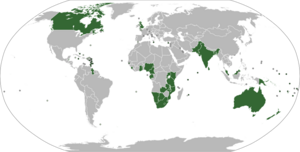
After World War II began in the late 1940s, the British government started planning for its colonies in Africa, Asia, and the Americas to become independent. British leaders initially planned a slow process, but unrest and fears of Communist influence encouraged them to speed up self-governance. Compared to other European empires, which had violent wars for independence, Britain's process of decolonization in the Caribbean was relatively peaceful.
To unite its Caribbean colonies, Britain formed the West Indies Federation in 1958. However, the federation broke apart when its two largest members, Jamaica and Trinidad, gained independence in 1962. Trinidad then joined with Tobago to become Trinidad and Tobago. The eastern Caribbean islands, as well as the Bahamas, became independent in the 1960s, 1970s, and 1980s. Guyana became independent in 1966. Britain's last colony on the American mainland, British Honduras, became self-governing in 1964 and was renamed Belize in 1973, gaining full independence in 1981. A dispute with Guatemala over claims to Belize remained.
Remaining Territories
Although many British Caribbean territories became independent, Anguilla and the Turks and Caicos Islands chose to return to British rule after starting on the path to independence. The British Virgin Islands, Bermuda, the Cayman Islands, Montserrat, and the Falkland Islands also remain under British control. In 1982, Britain defeated Argentina in the Falklands War, a conflict where Argentina tried to take control of the Falkland Islands. In 1983, the British Nationality Act 1981 renamed the existing British Colonies as "British Dependent Territories."
Historically, people in the colonies had the same citizenship as people in Britain. However, a series of laws passed by the British Parliament between 1968 and 1982 limited their rights and changed their citizenship without their consent. In 2002, the "British Dependent Territories" were renamed the British Overseas Territories. While "British Overseas Territories Citizenship" remained the main citizenship for most territories, the restrictions on living and working in the United Kingdom for these citizens were removed.
The eleven inhabited territories govern themselves to different degrees and rely on the UK for foreign relations and defense. Most former British colonies and protectorates are now part of the Commonwealth of Nations, a group of 52 independent member states. Fifteen Commonwealth realms, including Canada and several Caribbean countries, still recognize the British monarch, Queen Elizabeth II, as their head of state.
List of Colonies
Former North American Colonies
Canadian Territories
These colonies and territories, along with Bermuda, were known as British North America after the United States became independent. They joined to form modern Canada between 1867 and 1873, unless noted otherwise:
- British Columbia (was part of Oregon Country before 1846)
- Province of Canada (formed from Upper Canada and Lower Canada in 1841)
- Nova Scotia
- New Brunswick
- Dominion of Newfoundland (joined Canada in 1949)
- Prince Edward Island
- Rupert's Land (became part of Canada as Manitoba and the Northwest Territories)
Thirteen Colonies
The Thirteen Colonies became the first states of the United States after 1781:
- Province of Massachusetts Bay
- Province of New Hampshire
- Colony of Rhode Island and Providence Plantations
- Connecticut Colony
- Province of New York
- Province of New Jersey
- Province of Pennsylvania
- Delaware Colony
- Province of Maryland
- Colony of Virginia
- Province of North Carolina
- Province of South Carolina
- Province of Georgia
Other North American Colonies
These colonies were gained in 1763 and given back to Spain in 1783:
- Province of East Florida (from Spain, given back to Spain)
- Province of West Florida (from France, given to Spain)
Former Colonies in the Caribbean and South America
These countries were part of the British West Indies before gaining independence in the 1900s:
- Antigua and Barbuda (independent in 1981)
- The Bahamas (independent in 1973)
- Barbados (independent in 1966)
- Belize (independent in 1981; formerly British Honduras)
- Dominica (independent in 1978)
- Grenada (independent in 1974)
- Guyana (independent in 1966; formerly British Guiana)
- Jamaica (independent in 1962)
- Saint Kitts and Nevis (independent in 1983)
- Saint Lucia (independent in 1979)
- Saint Vincent and the Grenadines (independent in 1979)
- Trinidad and Tobago (independent in 1962)
Current Territories
These British Overseas Territories in the Americas are still under the United Kingdom's control:
- Anguilla
- Bermuda
- British Virgin Islands
- Cayman Islands
- Falkland Islands
- Montserrat
- Turks and Caicos Islands
See also
 In Spanish: Colonización británica de América para niños
In Spanish: Colonización británica de América para niños


